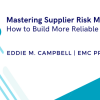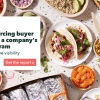COVID-19 and Its Impact on the Supply Chain
Remember when the U.S. was virtually held hostage by OPEC? If they raised the price per barrel, U.S. consumers were stuck with higher prices at the gas pump. And then along came fracking. Boom! The U.S. took the alpha role in energy production. Carbon emissions notwithstanding, this new power freed the U.S. economy from dependance on other oil-producing nations.
Now let’s look at plastic. It’s been vilified because of its polluting nature. Just think about the nation-sized floating islands of plastic in our oceans. Then along came COVID and now plastic is back. Regardless of its negative impacts, the need for safety during the pandemic is not only making plastic essential, but the increased demand for it is raising havoc in supply chains.
In the case of oil, there wasn’t enough until the new fracking technology came along. In the case of plastic, there was too much until COVID-19 made it essential. Now there’s not enough. All of which is to suggest that economic change often makes what was taken to be common sense look like nonsense. In other words, all is impermanent, including the state of economic supply chains.
Is the World Ever Ready for Change?
For years, the assumption was that a global economy is a good thing. One of the ideas supporting this is that businesses could produce at lower prices and consumers would never have to worry about shortages. But what happens in a global emergency is that all economies start producing the same things?
In the case of COVID, manufacturing turned its focus to disinfectant bottles, caps and dispensers—and away from shampoo, conditioner and other products, whether personal care, beverage or ketchup.
And then there’s the question of supply chain interruption. According to Plastics Today, the U.S. imports 1.1 billion worth of plastic bottles each year from China, Canada and Mexico, and 7.5 billion worth of plastic lids. With everybody focused on PPE, it’s having a negative impact on other consumer goods categories.
Brands are experiencing late deliveries and, in some cases, out-of-stock products. Pricing has increased from 5% to 10% as brands seek to find new vendors for their bottles. Lead times for packaging are doubling and tripling.
According to one brand owner, “first we were told packaging would be available in June 2021, now it’s being pushed to August by suppliers all around the United States.” In order to stay in business, this company has started to produce hand sanitizer, as plastic bottles for its beauty products are simply not available.
If you can’t beat ‘em, join ‘em.
What Happens When You Come Up Short? You Improvise.
At my own firm, we’ve been challenged with finding alternative plastic bottles, caps and dispensers, just to keep our clients’ products on the shelf. One of my clients was not able to get the bottle they had been using for years and were forced to change from a black PETE bottle to a clear PETE bottle with a slightly different shape.
On top of that, their trigger sprayer suppliers couldn’t provide the trigger in the same color they had used for over a decade and were again forced to change. This is a national brand and by Q3 2020, they went from a black bottle with a color trigger to a clear bottle with a white trigger. On the surface this may not seem like a big deal, but the labels needed to change too – what works visually on black may not look good on clear. Even small changes can leave consumers wondering, “Is this the same product I’ve been buying for years?”
The above is hardly an isolated incident. We also saw other products and brands within the same categories making similar shifts in bottle, trigger and cap colors. These shifts were not “on-brand,” so they were most likely driven by supply chain issues as well. I believe that supply chain challenges will be with us well into 2022.
We are currently in the final stages of a major brand and packaging redesign for one of our clients, and we are developing a plan for a two-stage rollout. The first stage will be with new graphics and white triggers and caps later this year, then stage two will be Q1 2022 with brand color triggers and caps. That said, as we get more specific information, I’m starting to think this may actually look more like Q2 2022 or even Q3 2022 until we get back to pre-COVID supply chain normalcy.
What Did We Learn From All of This?
For me it’s been how to balance cost, timing and sourcing. How can I help consumer product companies navigate shortages and use design to help them solve problems — both visually and structurally? Sourcing from one region of the world or one country is probably a bad strategy long term. Also, having some regional or “Made in the USA” sources in the vendor/supplier pool is a good idea.









